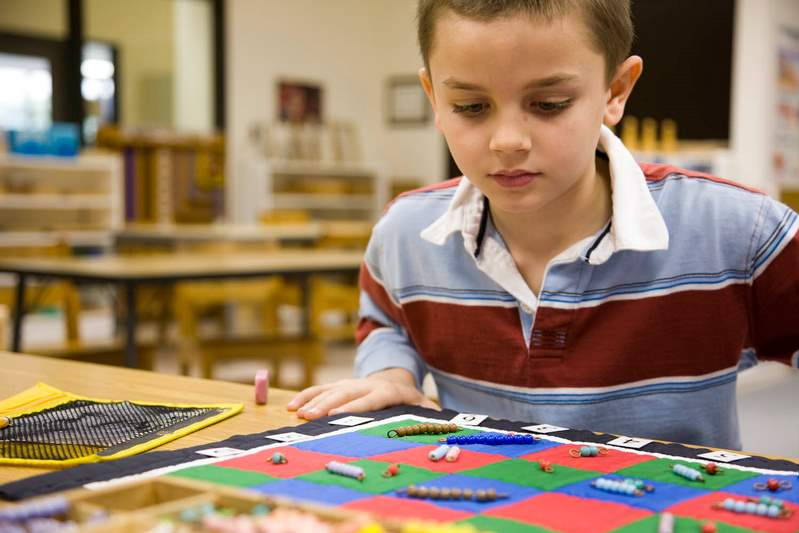October 30, 2022
If you read my recent blog post you’ll know that I have been recounting a conversation with typical prospective Montessori parents, Mr. and Mrs. S. They have a 14-month-old toddler, and have just observed in Montessori environments for toddlers and 3- to 6-year-olds. They are surprised by the children’s independence, and by the overall atmosphere of calmness and happiness in both environments. They are also brimming with questions and reactions. As Mr. S phrases it, “Although I was very impressed by the children’s purposefulness and engagement, it’s just not what I was expecting. It’s not what I’m used to. How on earth do you accomplish this?”
“Can I assume, then, that you didn’t have the opportunity to attend Montessori as a child?” I ask. “And, neither did I. Perhaps it would be helpful at this point to contrast Montessori to the kind of traditional classroom in which we were educated.
For myself, what I remember is sitting at a desk while the teacher stood in front of the class lecturing and underscoring points by writing on the chalkboard. Does that sound familiar? It’s a group of about 25 children of the same age. The teacher sets the agenda. ‘It’s time for Social Studies. Please get out your textbooks and turn to chapter 7 on page 135’ Information is divided into units, and children progress through this district-wide curriculum as a group. What we can say about this traditional classroom is that it is very good at quantifying the information to which children are exposed. But, is learning the same thing as mere exposure? I think you would agree that it’s not.
Here’s where the problem comes in. For some of those 25 children, whatever is contained in chapter 7 is just a little too hard. Perhaps the class moved on from chapter 6 before they really understood the concept. What do these children conclude from the experience? Probably that ‘I am not as smart as others or, ‘Social Studies is hard and I’m not very good at it.’
For another significant portion of this group of children, whatever is contained in chapter 7 is too easy. They are the ones looking bored, doodling, or staring out the window daydreaming. What do they conclude from the experience? That Social Studies is dull and boring, and that school is often a waste of time.
And what of the rest of the class? Chances are the teacher has pitched the lesson to match their level. But even within this group for whom the lesson contains the right degree of difficulty, how many happen to be interested in Social Studies at this particular moment? Probably, it’s only a handful. So, in this class of 25 children, the vast majority at any given time and in any given lesson, are overwhelmed, underwhelmed, or disinterested. The teacher does the best she can under the circumstances, trying to make a dry lesson interesting and trying not to leave anyone behind, but she’s fighting a losing battle. The fault is not with her, but with the system.
In any group of children, even those of the same age, there will be great variation in their pace and readiness, and interests. What we know about engagement (and the kind of long-term retention of knowledge that results from it) is that it depends on the intersection of two factors: interest and the right degree of challenge.
Now let’s consider the Montessori classroom that you just observed. Your observation was that the children seemed engaged in their activities and of their own volition. This surprised you, and you almost doubted the evidence of your own eyes. It turns out that a Montessori environment, unlike a traditional classroom, is set up specifically to create the circumstances that allow children to find that combination of interest and the right degree of challenge, most of the time.

A basic rule of a Montessori classroom is that a child can only choose an activity once the teacher has shown him/her how to use it. Lessons for this age group are usually given one-on-one, as the teacher performs an essential use of the material or activity, thus communicating its purpose and carefully demonstrating its sequence of steps.
Once the child has had a lesson, he adds that activity to his repertoire of choices. The learning really takes place not during the lesson, which is only an introduction, but over the ensuing days and weeks when the child chooses this activity of his own volition, repeats it, explores its many variations, and gradually perfects the skills inherent in it.
Montessori teachers are trained observers. They spend a significant amount of time each day watching every child in the classroom. Not only does she note which activities each child chooses, but how they use the materials and activities they choose. She is always looking for signs of mastery of one skill or concept and readiness for the next. When a child is introduced to a new activity, it is because she knows it will present the right degree of challenge – not too hard, and not too easy. In this way, each child can progress from success to success at his or her own unique pace of developmental readiness, neither so fast that it exceeds their understanding nor so slow that it’s boring.
In a classroom where children are free to choose their own activities, they tend to choose those that are most interesting to them at this particular moment, as well. So, do you begin to see why these children are so engaged so much of the time? They are inhabiting that magic intersection of interest and the right degree of difficulty.
